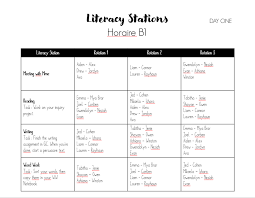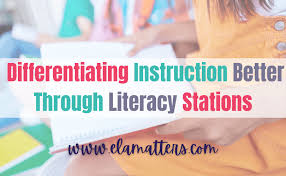When we think of centers, we think of elementary. But what if there was a way to adapt centers to middle school and high school? What would it look like? How would it be organized? Those are questions I was asking myself last year when I taught ELA. I was thinking about how I could differentiate my instruction since it is a huge part of my practice and beliefs. It was also something I used to do when I was teaching elementary. If you’re also interested in using centers (I called them “stations” in middle school to make it sound cooler for my teenagers) or if you’re just curious to know what it could look like, here are 3 things to consider when teaching through literacy stations in order to be successful.
Teaching students expectations
Before we get into how to organize and plan your stations, let’s talk about setting your students up for success. For them to be able to work through stations, and you to teach, they need to be independent. And for them to be independent, they need to know EXACTLY what you expect of them. As we know, it’s not enough to say it, we also have to explicitly teach behaviours to our students. Greatly inspired by the Daily 5 model, these were my expectations for my grade 6 students :
| Student | Teacher |
| Work the whole time | Work with students in small-group or 1:1 |
| Have all your materials ready | |
| Use the right tone of voice | |
| Use your resources | |
| Stay in one spot |
After talking with my students about my expectations for them, I would also talk with them about why. Why do they need to be doing all of this? We would talk about their student job, which are the expectations we talked about previously, and my teacher job, which is to work in small groups with students. At this point, I introduced and explained the stations to the students and we would finish off by doing one of them.
Here is where “explicitly teaching behaviours” comes in and I would encourage you to be very strict regarding your level of tolerance for each expectation. Do not hesitate to stop your class as soon as one student is not following your expectations and talk to the class about why you stopped them. In middle school, it took 2 or 3 practices before my students had the routine down to a T.
Finally, even if you explain and present all the stations on the first day, do not have your students do all of them right away. It’s better to start with one station so you can make sure that students understand what to do and do it well. Only then would I introduce the next station. It’s important to build your student’s resiliency and independence progressively for them to be successful when it comes to stations. This also means that you shouldn’t be doing small-group instruction until your students are completely independent through ALL the stations.
Setting up the stations
In my class, I had 3 stations for our ELA bloc, which was 50 minutes long, but you could easily have more, depending on what you’re working on. Again, the key for your stations to be successful is for your students to be completely independent. They SHOULDN’T be coming to you for questions or help because during that time, you will be meeting with your kiddos in small groups or maybe even 1:1. You need zero interruptions to achieve your goals. Some key elements to consider when planning and setting up stations :
- Independence : I can’t say again how important that is. Always keep this in mind when working with stations in your class.
- Accountability : because you’re not checking EVERYTHING that your students are doing while you’re teaching in small-groups, they need to be held accountable. That means that your students should have something to show when they complete a station, but it also shouldn’t be taking you hours to mark. In fact, you shouldn’t be marking. Instead, you should be able to have a quick look at the student’s work and know that the student did it or not.
- Open : to make your life easier, it’s better to plan stations that are “open”. The directions for these stations should stay the same throughout the year, but the content should be changing based on your curriculum and your long-range plan. If not, then you are more likely to have to explain your stations over and over again because the students will not be used to what is expected of them.
To help you have a better idea of what that might look like, here is how I organized my stations in my grade 6 EFI classes :
- Reading : students would go on Newsela, choose an article they’re interested in and read. During that time, they had to practice the reading strategy (ie. : making connections) that we were focusing on, and record notes in their reading notebook. If students finished early, they could read a book of their choosing or keep reading on Newsela (my grade 6s LOVED it).
- Writing : students worked in their writing notebooks during that time. I taught writing through “genre study”, therefore we would spend about 5-6 weeks analyzing and practicing a certain type of text (ie. : persuasive, procedure, response). My rule was “If you’re done writing, keep writing.” so my students always knew to go back and check their texts or to start writing a new text. I would also sometimes let them pair up and give feedback to each other to help them improve their writing. I would also plan for the new writing genre to “overlap” the old one. That way, as we were learning the structure of a new genre, students were still busy working on their final texts and submitting them for assessment during literacy station time. No time wasted!
- Word Work : students reviewed and practiced their spelling words for the week. They had different options to choose from to help them practice and review their words. Since I taught in a French Immersion class, many students struggled with English spelling even though most of them had English as a first language, and even though they were in grade 6. Hence, I used the program “Words Their Way” to teach spelling to my students, and “Word Work” was one of our stations so that students could practice their words at school (not everyone can do so at home).
My stations were about 12-15 minutes long and we would do them three times a week. Why? Because I would teach a whole-group lesson on Mondays (reading) and Wednesdays (writing). Now, this is how I did it in my class, but you can be so creative with your stations! Here are a couple more ideas :
- Fluency : help your students practice their reading fluency with some fun activities like choir reading or poetry
- Vocabulary : let students play some vocabulary games like Scattergories, Bananagrams or Scrabble. Challenge them to use vocabulary words studied in class! Hold them accountable by keeping a class record of the longest word spelled or the most classroom words used.
- Reading circle : if you do reading circles in your class, you could easily add this as a station. Have one student be the moderator for the conversation and another take notes that will then be handed in to you. Or just let your students read together and exchange freely.
- Audiobooks/podcasts : sometimes, listening can also be nice. Let your students enjoy an audiobook or a podcast as a station and ask them to reflect on what they heard.
Really, when it comes to stations, the sky’s the limit!
Planning small-group instruction
All this hard work pays off because it allows you to do small-group instruction, one of the most powerful ways to teach in my opinion. You get to help your students progress at their own pace, focusing on their strengths and their struggles, but you also get to know them at such a personal and individual level. But how do you plan for small-group instruction when you have multiple classes with multiple needs? Here are a few tips based on my experience :
Build your small groups
To be able to meet your student’s needs, you will need to define your criterias. Is it their reading level? Their comprehension skills? What benchmark will you use to form your groups? It is very likely that you will have to assess your students in some way to answer those questions. After doing so, use that information to guide your practice. I would recommend between 4-6 students per group whenever possible. To give you an idea of how this would work in real life, here is the schedule I had in my classroom :

You’ll also notice that I had the directions for the task written underneath the station’s name to remind students of what they were supposed to do. To organize my groups, I used my students’ results from the “Vernon Reading Assessment”, which was mandatory in my previous school district (SD), as well as their results from the spelling inventory of the “Words Their Way” program.
Choose a learning target
Once you’ve built your groups and you know what you want to work on, it’s time to decide what you want the goal to be for that specific group of students. Do you want to improve their comprehension skills? Expand their vocabulary? Teach them inferences? Choose what your goal will be for them and plan accordingly. Personally, I used this AMAZING resource that was recommended to me by the Literacy Helping Teacher of my previous SD during a workshop : The Next Step Forward in Guided Reading by Jan Richardson. It is mainly for K-8, so I would recommend it for middle-school teachers, even more those who teach ELL students like myself. Based on the Fountas and Pinnell reading levels, this book has EVERYTHING you need to plan your instruction. In addition to this, I also used the Comprehension Toolkit by Stephanie Harvey.
Monitor your student’s progress
During your meetings with your students, you should make sure you have a space in which you can take notes. Write down what seems easy or hard for them to help you reflect on the progress that they are making. This will also help you plan your next steps with them and will even make grading easier. Also, don’t forget to plan some way for students to assess and monitor their own progress since this will help motivate them further. Unfortunately, I can’t share mine since they come from the resource mentioned above (The Next Step Forward in Guided Reading) and they are under license.
Stations can be a powerful tool for instruction, although they can also be time consuming. Besides that, it is so worth it for the students. The progress is unreal! I hope you feel inspired and ready to try out literacy stations in your classroom, whether you are in middle school or high school.

